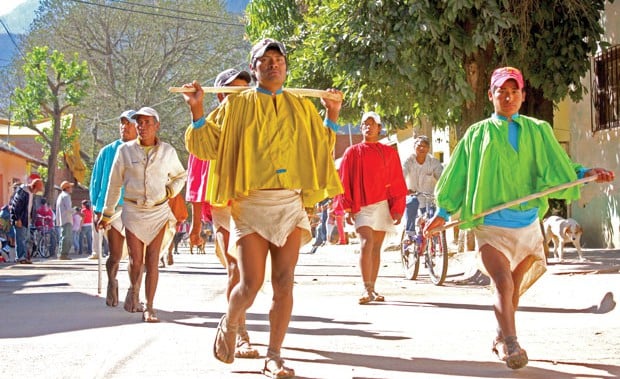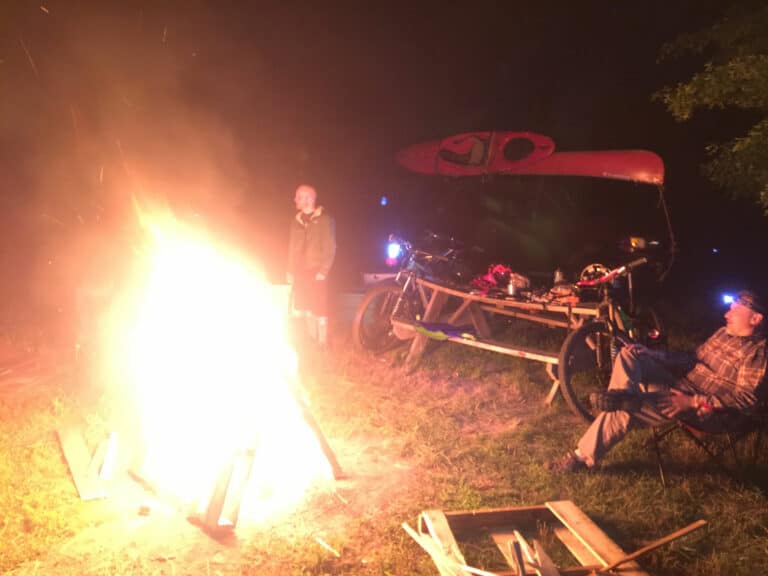Just for Kicks: Huarache-clad Tarahumara combine soccer and running in a 50-mile ball-kicking race. Photo: Tania Maldonado
It was the second-most amazing athletic performance I had ever witnessed. And though I was in Mexico’s Copper Canyons with the Tarahumara, it had nothing to do with barefoot running.
I was waiting for Arnulfo—yes, that Arnulfo, the huarache-clad Tarahumara runner featured in the bestselling book Born to Run. The most successful Tarahumara athlete of all time lived in a one-room, mud-brick adobe hut, where he and five others shared a single bed and open-fire stove. In the ox-plowed fields outside his hut, stubbles of corn stalks clattered in the dry wind. A wiry goat bleated.
Arnulfo was hauling water from a nearly dry spring two miles down the canyon. While awaiting his return, I wandered over to my friend Rod, who was hunkered in the soft shade of an old-growth pine forest. Rod picked up a pine cone and threw it at me. I grabbed a rotted, knotted pine branch and swatted at it.
“This is how baseball must have started,” Rod said. We felt primeval in the ancient forest, swinging our club and shattering pine cones. But really we were two pasty-white gringos with video cameras, hoping to document the last vestiges of Tarahumara traditions before they were destroyed by drug trafficking, clear-cutting, mining, and the worst drought in Mexico’s recorded history.
A Tarahumara woman watched us quietly from the edge of the forest. Her scarlet blouse and sapphire skirt flapped in the canyon breeze. Her night-black hair was pinned back by a hand-carved wooden barrette. She tried not to make eye contact. It was taboo for Tarahumara women to speak or even look at a chobochi (their word for all non-Tarahumara people).
Rod drew a five-sided plate in the dry earth with the broken end of the pine branch. Instead of pine cones, I grabbed an old, dog-chewed tennis ball from my backpack. Rod swung too hard and fouled off several pitches. He blamed it on the bat. One foul ball landed near the Tarahumara woman. She pretended not to notice.
“Do you want to play?” I asked her in broken Spanish. She sat stoic and motionless, eyes forward, hands folded in her lap. But her eyes betrayed her. She sneaked sideways glances at the gringos swatting at a ball with a pine stick.
“Come on, take a few cuts,” Rod said.
Finally, she stood and walked over to the home plate we had drawn in the dirt. Her name was Josefa, and she had never swung a bat. She held it with one hand, low and parallel to the ground. I tossed an underhand pitch as gently as I could. She clobbered it over the trees with a vicious one-handed swipe. Rod’s jaw dropped to the pine-needled floor of the forest.
I threw the next pitch overhand, and again she crushed it over the trees. I peppered her with fastballs, curveballs, spitballs. She hit every one.
“She’s a friggin’ slugger,” Rod said.
Josefa tried not to smile.
Finally Arnulfo returned with water, and we were on our way to an athletic feat even more astounding than Josefa’s home run derby. Arnulfo and 50 other Tarahumara runners were competing the next day in a rarajipari, a centuries-old ball-kicking race. It was a hybrid of running and soccer: two teams each kicked a wooden ball for dozens of miles along steep canyon paths. If the ball went off trail, runners used sticks to dig the ball out of thorn bushes and rocky gulches. As always, the Tarahumara wore their traditional handmade huaraches, which consisted of worn tire tread strapped to their feet with goat leather.
 Before the race, I watched the teams carve wooden balls out of a sacred ash tree. I figured the ball-kicking would be easy, like dribbling a soccer ball. Not quite. After a few kicks, I hobbled off with a bruised foot, splintered toenail, and a bloody, swollen toe.
Before the race, I watched the teams carve wooden balls out of a sacred ash tree. I figured the ball-kicking would be easy, like dribbling a soccer ball. Not quite. After a few kicks, I hobbled off with a bruised foot, splintered toenail, and a bloody, swollen toe.
“That ain’t no soccer ball,” I mumbled to Rod. “That’s solid wood.”
The next day, I ran alongside Arnulfo’s team in the rarajipari. An hour before the race, Arnulfo handed me a traditional Tarahumara blouse and a loincloth, both of which were made for a five-foot Tarahumara runner, not a six-foot American. I felt obligated to wear traditional Tarahumara huaraches as well. My feet screamed with each step. The crowds laughed at the costumed gringo limping farther behind.
Even though I never once kicked the ball, I could barely keep up. The Tarahumara ran faster kicking a hard wooden ball over rocky singletrack than I could run flat-out. They flung the wooden ball thirty yards ahead with spot-on accuracy, like a golfer dropping a tee shot next to the hole, then chased it down and slung it again.
As the fifty-mile race wore on, teammates held torches to light the trail. Tarahumara onlookers wagered with piles of clothes and crafts. They cast spells on the opposing team using rattles and drums.
At dusk, when Arnulfo’s team kicked their ball across the finish line first, I trailed several meters behind, feet blistered, eyes wet. Never before had I witnessed such endurance. It was true: the Tarahumara really were the toughest people on the planet. No one else could endure 50 rugged miles at breakneck speed kicking a wooden ball while nearly barefoot. Put Meb or Geb—or Pele or Rinaldo—in a pair of huaraches, and they would get dusted by the Tarahumara.
They weren’t born with callused feet and gritty resolve. The Tarahumara earned their toughness every day of their hardscrabble lives. There was nothing genetic about it.
There was nothing romantic about it, either. They may be the world’s toughest runners (and most promising baseball prospects), but they feel pain just as much as we do. They still wince when they stub their toes. They hurt with hunger pangs when their crops fail and their corn cribs are empty.
Millions of Americans are now wearing minimalist running shoes, and that’s probably a good thing. We chabochi don’t need as much cushioning—in our shoes or in our lives. But it will take more than changing our footwear to tap the Tarahumara’s toughness. Their endurance goes far beyond running. They are as deep as their ancestral canyons, pure as the water that carved them. And as vulnerable.







